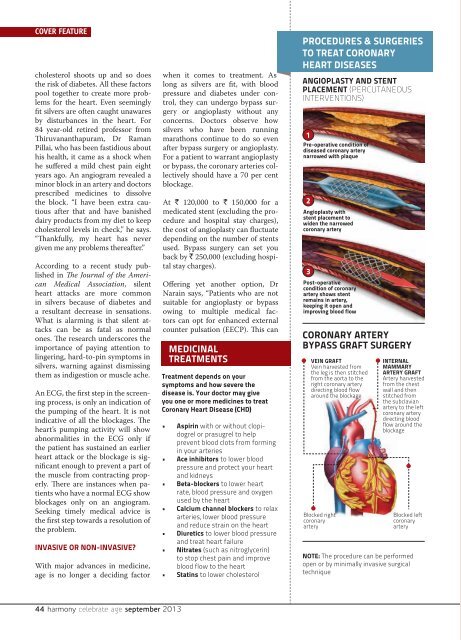Sept_13
Sept_13
Sept_13
Create successful ePaper yourself
Turn your PDF publications into a flip-book with our unique Google optimized e-Paper software.
COVER FEATURE<br />
cholesterol shoots up and so does<br />
the risk of diabetes. All these factors<br />
pool together to create more problems<br />
for the heart. Even seemingly<br />
fit silvers are often caught unawares<br />
by disturbances in the heart. For<br />
84 year-old retired professor from<br />
Thiruvananthapuram, Dr Raman<br />
Pillai, who has been fastidious about<br />
his health, it came as a shock when<br />
he suffered a mild chest pain eight<br />
years ago. An angiogram revealed a<br />
minor block in an artery and doctors<br />
prescribed medicines to dissolve<br />
the block. “I have been extra cautious<br />
after that and have banished<br />
dairy products from my diet to keep<br />
cholesterol levels in check,” he says.<br />
“Thankfully, my heart has never<br />
given me any problems thereafter.”<br />
According to a recent study published<br />
in The Journal of the American<br />
Medical Association, silent<br />
heart attacks are more common<br />
in silvers because of diabetes and<br />
a resultant decrease in sensations.<br />
What is alarming is that silent attacks<br />
can be as fatal as normal<br />
ones. The research underscores the<br />
importance of paying attention to<br />
lingering, hard-to-pin symptoms in<br />
silvers, warning against dismissing<br />
them as indigestion or muscle ache.<br />
An ECG, the first step in the screening<br />
process, is only an indication of<br />
the pumping of the heart. It is not<br />
indicative of all the blockages. The<br />
heart’s pumping activity will show<br />
abnormalities in the ECG only if<br />
the patient has sustained an earlier<br />
heart attack or the blockage is significant<br />
enough to prevent a part of<br />
the muscle from contracting properly.<br />
There are instances when patients<br />
who have a normal ECG show<br />
blockages only on an angiogram.<br />
Seeking timely medical advice is<br />
the first step towards a resolution of<br />
the problem.<br />
INVASIVE OR NON-INVASIVE?<br />
With major advances in medicine,<br />
age is no longer a deciding factor<br />
when it comes to treatment. As<br />
long as silvers are fit, with blood<br />
pressure and diabetes under control,<br />
they can undergo bypass surgery<br />
or angioplasty without any<br />
concerns. Doctors observe how<br />
silvers who have been running<br />
marathons continue to do so even<br />
after bypass surgery or angioplasty.<br />
For a patient to warrant angioplasty<br />
or bypass, the coronary arteries collectively<br />
should have a 70 per cent<br />
blockage.<br />
At ` 120,000 to ` 150,000 for a<br />
medicated stent (excluding the procedure<br />
and hospital stay charges),<br />
the cost of angioplasty can fluctuate<br />
depending on the number of stents<br />
used. Bypass surgery can set you<br />
back by ` 250,000 (excluding hospital<br />
stay charges).<br />
Offering yet another option, Dr<br />
Narain says, “Patients who are not<br />
suitable for angioplasty or bypass<br />
owing to multiple medical factors<br />
can opt for enhanced external<br />
counter pulsation (EECP). This can<br />
MEDICINAL<br />
TREATMENTS<br />
Treatment depends on your<br />
symptoms and how severe the<br />
disease is. Your doctor may give<br />
you one or more medicines to treat<br />
Coronary Heart Disease (CHD)<br />
• Aspirin with or without clopidogrel<br />
or prasugrel to help<br />
prevent blood clots from forming<br />
in your arteries<br />
• Ace inhibitors to lower blood<br />
pressure and protect your heart<br />
and kidneys<br />
• Beta-blockers to lower heart<br />
rate, blood pressure and oxygen<br />
used by the heart<br />
• Calcium channel blockers to relax<br />
arteries, lower blood pressure<br />
and reduce strain on the heart<br />
• Diuretics to lower blood pressure<br />
and treat heart failure<br />
• Nitrates (such as nitroglycerin)<br />
to stop chest pain and improve<br />
blood flow to the heart<br />
• Statins to lower cholesterol<br />
PROCEDURES & SURGERIES<br />
TO TREAT CORONARY<br />
HEART DISEASES<br />
ANGIOPLASTY AND STENT<br />
PLACEMENT (PERCUTANEOUS<br />
INTERVENTIONS)<br />
1<br />
Pre-operative condition of<br />
diseased coronary artery<br />
narrowed with plaque<br />
2<br />
Angioplasty with<br />
stent placement to<br />
widen the narrowed<br />
coronary artery<br />
3<br />
Post-operative<br />
condition of coronary<br />
artery shows stent<br />
remains in artery,<br />
keeping it open and<br />
improving blood flow<br />
CORONARY ARTERY<br />
BYPASS GRAFT SURGERY<br />
VEIN GRAFT<br />
Vein harvested from<br />
the leg is then stitched<br />
from the aorta to the<br />
right coronary artery<br />
directing blood flow<br />
around the blockage<br />
Blocked right<br />
coronary<br />
artery<br />
INTERNAL<br />
MAMMARY<br />
ARTERY GRAFT<br />
Artery harvested<br />
from the chest<br />
wall and then<br />
stitched from<br />
the subclavian<br />
artery to the left<br />
coronary artery<br />
directing blood<br />
flow around the<br />
blockage<br />
Blocked left<br />
coronary<br />
artery<br />
NOTE: The procedure can be performed<br />
open or by minimally invasive surgical<br />
technique<br />
44 harmony celebrate age september 20<strong>13</strong>


